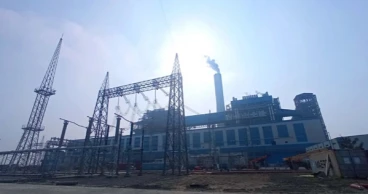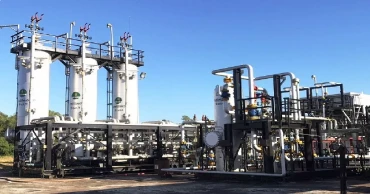National grid
Kurigram char residents pay for power they never receive
What was supposed to be a blessing has turned into a source of frustration for hundreds of families living in remote char areas of Kurigram’s Ulipur upazila.
A solar electrification initiative, meant to bring power to homes beyond the reach of the national grid, has instead left residents disillusioned, and still in the dark.
Back in 2021, a total of 375 families from Chark Ghughurmari and Sukherbati, located in ward-8 of Saheber Alga Union, were provided with solar panels under a project reportedly managed by local public representatives and Awami League leaders and activists.
Each family was asked to pay between Tk 500 and Tk 1,000 in instalments for the installation of the solar units. But, according to the residents, the panels have remained dysfunctional from the very beginning.
Locals complain that the systems — comprising low-capacity panels, batteries and basic wiring — have either stopped working entirely or were never functional to begin with. Damaged batteries and faulty wiring are common, with many units rendered completely useless.
Dharla’s wrath leaves over 50 families homeless in Kurigram, hundreds more at risk
Residents such as Ruhul Amin, Abdur Razzak Pramanik, Abdus Sabur Pramanik and Kashem Ali said their villages still lack access to the national electricity grid.
At the time of installation, they were assured that payment could be made in instalments. But within eight to nine months, many began receiving official electricity bills from the Kurigram-Lalmonirhat Palli Bidyut Samity’s Ulipur zonal office despite the fact that the solar panels provided no power.
Repeated complaints to the relevant authorities have gone unanswered, with no maintenance or inspections carried out.
Meanwhile, bills continue to arrive.
“We can’t even light a bulb with these panels. We no longer want the solar units. If proper grid electricity is given, we are willing to pay monthly bills,” said Ruhul Amin.
Zohur Uddin, 67, said he paid Tk 500 for a 50-watt solar panel, but it failed almost immediately. “It barely lasted a day. Still, we keep receiving bills every month,” he lamented.
Lutfor Pramanik, 46, who received a 30-watt panel, said he now owes Tk 2,300 for the period between 2021 and 2025, despite never having received reliable power from the system.
Locals alleged that Palli Bidyut staff members now deliver electricity bills by hand each month at the riverbank, but no officials have visited the char to investigate or repair the malfunctioning solar systems.
When contacted, Tariqul Islam, Deputy General Manager of the Ulipur zonal office of Kurigram-Lalmonirhat Palli Bidyut Samity, acknowledged the issue.
“We are removing the panels upon request from those who no longer want them. Those who wish to keep them may do so. Had they paid bills on time, the arrears wouldn’t have accumulated. They are still liable to pay as per rule,” he said.
Zakir Hossain, Senior General Manager of the Palli Bidyut Samity, said he was unaware of the matter.
“Since you’ve raised it, I will have our Ulipur office look into the situation. If indeed the solar systems are faulty, we will consider waiving the bills based on customer applications,” he said.
5 months ago
Bangladesh unlikely to get electricity from Rooppur nuke plant before 2026
Even though most of the agencies concerned are claiming that the Rooppur Nuclear Power Plant (RNPP) is ready to start power generation, experts say that the plant is unlikely to be able to deliver any electricity before 2026.
According to official sources and industry insiders, there is still a long way to go before the RNPP can start commercial operation by the end of 2025.
“There are a lot of issues that still need to be resolved with Russia, including the repayment mode of the Russian loans and the test run of the plant,” a highly placed source told UNB.
The construction of the country’s first nuclear plant, with two units having a total capacity of 2,400 MW of electricity generation, began in November 2017 with a target to commission the first unit in 2024 and the second unit in 2025.
But neither of the units is ready for commissioning due to various unresolved issues related to delivering its output to the national grid.
Bangladesh conceived the idea of establishing the RNPP in 2009 and signed a Memorandum of Understanding with the Russian Federation on May 13, 2009, on the 'Peaceful Uses of Nuclear Energy' and engaged the Russian nuclear power agency Rosatom as the contractor for the plant’s construction.
Alexey Likhachev, Director General of Rosatom, recently visited Dhaka and met Chief Adviser Dr Muhammad Yunus to discuss the project’s progress and shared its unresolved issues, seeking to address them.
He also expressed Russia's commitment to facilitating the successful completion of the project, with a strong focus on safety, quality, and compliance with international standards.
Both sides discussed the merits of revising the Intergovernmental Credit Agreement (IGCA) by extending the credit utilization period until the end of 2026.
Rosatom readies Rooppur NPP unit-1 for 2025 launch
But sources close to Rosatom said that the main focus of its chief was finding a solution to the repayment of the loans by Bangladesh, which has encountered difficulties following the start of the war in Ukraine due to US sanctions on Rosatom.
Sources said that the Russian side proposed that Bangladesh open a branch of one of its state-owned banks so that Rosatom could deposit its money in the Russian bank. “But so far no progress has been made on this issue,” the sources stated.
Regarding the repayment of the Russian loan, which is set to start from 2027 as per the agreement between Dhaka and Moscow, Dr Md Zahedul Hassan, Project Director of the Rooppur Nuclear Power Plant Project, declined to comment on the matter.
He, however, claimed that Unit-1 of the project has achieved 94 percent progress and is now waiting for the power grid to be ready for connection.
“We are now conducting individual tests of the plant's equipment and waiting for the grid line to be ready from Power Grid Bangladesh PLC to begin the test run of Unit-1,” he told UNB.
He also informed that after connecting with the grid line, the RNPP project will need another 4-6 months to begin commercial operations.
Regarding the power grid line, Md Delowar Hossain, Project Director of Power Grid Bangladesh, informed that a total of six grid lines are being contracted by his agency.
“Of these, three lines are ready while the remaining three are under construction. If the RNPP wants to start its first unit, they can do so,” he stated.
However, official sources at the Bangladesh Power Development Board (BPDB) indicated that even if the RNPP and Power Grid Bangladesh complete their works, it will be unlikely to start the commercial operation of Unit-1 until tariff and loan repayment issues are resolved.
Reactor assembly completed at Unit-1 of Rooppur nuke plant
He said that the RNPP authority had yet to complete the calculation of the project's total cost to offer a tariff for selling electricity to the BPDB.
“Almost two years ago, the RNPP authority organized a joint workshop for the BPDB officials to provide an idea about the possible tariff rate. But when they were asked about the project's total cost, including dismantling, they failed to share any information,” he explained.
Regarding the tariff issue, Dr Md Zahedul Hassan, Project Director of RNPP, admitted the matter and said that his organization has been preparing the tariff paper to begin negotiations with the BPDB.
A senior official from the BPDB, however, stated that they have made a preliminary calculation based on data derived from discussions with BAEC and newspaper reports, and the tariff for each unit of electricity from the RNPP will be no less than Tk 10.
From the very beginning, confusion has surrounded its eventual levelized tariff or the possible generation cost of each unit of electricity, said the official.
On January 15, 2013, an agreement regarding a State Export Credit of US$ 500 million was signed for the preparatory phase of the construction works of the Rooppur Nuclear Power Plant.
The Bangladesh government signed a US$ 12.65 billion general contract (GC) in 2015 with the Russian Federation for building the 2,400 MW nuclear power plant at Rooppur. Each unit will generate 1,200 MW of power.
Cold run of diesel generator completed at Rooppur Nuclear Plant’s unit 1
Bangladesh signed a credit agreement with Russia to obtain $11.385 billion in Russian credit for the RNPP in July 2016. This credit will cover 90 percent of the project’s cost.
9 months ago
Petrobangla seeks to complete drilling of 48 wells by 2025 to add 618 MMCFD gas to national grid
State-owned oil, gas and minerals corporation Petrobangla seeks to complete the drilling of a total of 48 wells at different gas fields hoping to add 618 MMCFD to national grid by 2025.
This will be done through Petrobangla's own companies and outsourcing of contractors by next year.
"We're very serious about implementing the plan on time and if necessary, we will seek a waiver from the provision of a mandatory feasibility study to avoid a time consuming process", said a top official of the Petrobangla.
The official preferred anonymity as he is not authorised to talk to media.
The plan is to add a total of 618 million cubic feet per day (MMCFD) gas to the national grid when power, industries as well as many other sectors are reeling from gas shortage.
Read more: Action against officials of Petrobangla companies if fail to achieve target: Nasrul
According to an official document, obtained by UNB, of the planned 48 wells, 23 will be drilled using the rigs of the Bapex (Bangladesh Petroleum Exploration and Production Company Limited) while the remaining 25 will be done by the outsourcing of the contractors at the existing onshore gas fields under a crash programme.
"These wells will be drilled as part of the government's ongoing plan to increase the gas production from the local gas fields ", another top official of the Petrobangla told UNB, also wishing anonymity.
He, however, declined to comment officially as some of the wells' approval process still remains pending with the government's highest authority.
Sources said Petrobangla took up the programme against the backdrop of the declining gas production with depleting reserve positions.
The country's 20 gas fields, out of total 29, produce between 1,600 and 1,900 MMCFD gas while another 1000 MMCFD gas is being imported to meet the demand for about 4000 MMCFD.
Read more: Petrobangla invites offshore bidding for oil, gas exploration
Officials said the local fields are depleting fast and gas reserves are declining.
Currently there is 9 trillion cubic feet (TCF) of gas in the country's reserve, out of a total of 30 TCF while 21 TCF has already been produced.
The gas demand is growing fast as many of the gas-fired power plants and new industries are being set up across the country.
As per a scenario -2 of a projection of the Petrobangla, the country's gas demand will go up to 5,092 MMCFD in 2029-30, 6072 MMCFD in 2034-35 and 6,986 in 2040-41.
Actually, the plan for drilling 48 wells is a part of the ongoing plan under which drilling of a number of wells has already been completed, said another official of Petrobangla.
Read more: Petrobangla now plans to invite int’l bidding for onshore blocks for hydrocarbon exploration: Chairman
These wells include Bhola North-2, Togbi-1, Elisha-1, Srikail North-1, Shariatpur-1, Titas-24, Beanibazar-1, Koilash Tila-2, Sylhet-10, Rashidpur-2, and Sundalpur-3.
These newly drilled wells have now been contributing 126 MMCFD gas to the national grid, noted the official.
1 year ago
PM Hasina to inaugurate Matarbari coal-fired plant in December to add 600MW to national grid: Officials
The first unit of Matarbari coal-fired power plant in Maheshkhali of Cox's Bazar district is likely to go into production by this December, adding 600 MW of electricity to the national grid.
Prime Minister Sheikh Hasina is expected to inaugurate the plant, project officials told reporters this week.
A ship carrying 64,300 mts of coal for the Matarbari plant had arrived from Indonesia on June 23.
The 1200 MW power plant has been built on 1,414 acres of land in Matarbari and Dhalghata unions of Maheshkhali upazila of Cox's Bazar district.
Fire in garbage dump at Matarbari Thermal Power Project under control after 8 hours
Along with the construction of this power plant with Japanese funding on the coast of Cox's Bazar seven years ago, work has also started on the construction of port infrastructure and jetty for coal offloading from ships.
While visiting the area recently, it was seen that the project implementing company, Coal Power Generation Company Bangladesh Limited (CPGCL), is going ahead with the work of this mega project.
The work of the jetty for the coal discharge with the power plant is almost finished. Vessels have also started sailing at the jetty.
PM urges JICA to allow farmers to use wastage of sea water in the desalination project at Matarbari
The project has changed the entire landscape of the area, said officials.
Some 13,104 tons of coal will be required daily to generate electricity at full scale. Coal discharge jetties and silos have been constructed for this.
Coal required for 60 days has been kept in the huge silos. Up to 80,000 ton capacity mother vessels can directly enter the coal jetty. And it will take one and a half to two days to unload the coal from the mother vessel.
Two separate ashponds are kept to store ash for a lifetime of 25 years of the power plant. One has an area of 90 acres, another spread over 600 acres. Coal yard has been prepared on 80 acres of land for coal storage.
64,300 mts of coal for Matarbari coal-fired power plant arrives
A loan agreement on the project was signed between the Government of Bangladesh and JICA on June 16, 2014. The project cost has been estimated at Tk 51,800 crores.
Of this, Tk 43,921 crore will be given as project support by JICA and the remaining Tk 7,933 crore will be provided from the own funds of Bangladesh Government and CPGCBL.
According to project sources, 95 percent of the jetty and physical infrastructure work has already been completed and 90 percent of the overall physical infrastructure work has been done.
Executive Director Nazmul Huq, Matarbari coal-fired plant project said that PM Hasina will inaugurate the power plant in December.
Read more: People suffer as severe load shedding continues countrywide
“But we want to add 600 MW power from here before inauguration and that will happen. The first unit of the Matarbari coal-fired power plant is scheduled to be commissioned in January 2024, but we expect to be fully operational by this December,” he said.
He mentioned that the second unit will be commissioned in next July.
However, he said, electricity from both the units will be connected to the national grid.
The executive director mentioned that the project is being worked on by ensuring all necessary measures to prevent environmental pollution.
“The coal will be seen only once when the coal is unloaded from the ship. Then the coal will go directly from the jetty to the plant. It will not pollute the environment," he said.
Read more: 26,620 mts of coal for Rampal Power plant arrives at Mongla
Highlighting the overall status of the project, the executive director said, we have two parts of this project, one of which is the power plant, the other is the port.
Cox's Bazar Deputy Commissioner Muhammad Shaheen Imran told reporters that the Matarbari Coal Power Project is a priority project of the prime minister.
2 years ago
Gas from Bhola can be added to national grid next month: Nasrul
Gas from Bhola will be added to the national grid next month, said State Minister for Power, Energy and Mineral Resources Nasrul Hamid on Tuesday.
“We hope that we can start supplying gas from Bhola in the next month and it can be carried through CNG,” he said while talking to reporters after a meeting with Deputy Commissioners at Osmani Auditorium in the city.
Read more: Previously undiscovered gas found in Bhola North-2 field
Replying to a question about increase of gas price, Nasrul said “We said there will be a policy to sync the price of gas in coordination with the international market price every month and it will depend on the price of fuel and we will take steps in this regard.”
Asked about re-fixing the gas price, the minister said nothing can be said now.
“The irrigation season is starting and the month of Ramadan is also coming. We should work together keeping in mind the current situation of fuel in the global market,” he said.
The minister also urged the DCs to be more cautious in using gas and power at the district and division level.
He also asked the DCs to regularize the postponed bills of power in the district level government offices and keep vigil so the farmers can get uninterrupted power supply.
Nasrul also urged the DCs to ensure uninterrupted power supply on priority basis in hospitals, industries and agriculture sector.
He also asked them to consider whether the barren lands can be used to generate solar power and whether solar power can be used in the government buildings.
Read more: Retail gas prices hiked for power plants, industries and commercial users with effect from Feb 1
The school buildings of the government can be brought under the solar power system and for that the ministry will provide assistance, he assured.
Replying to a question about facing challenges in realising dues of power from the government offices, Nasrul said directives were given to regularize the power bill.
Asked about how to tackle the demand of electricity during summer, the minister said steps will be taken in this regard.
2 years ago
Rampal Plant starts electricity production, 660MW from unit-1 added to nat’l grid
The coal-fired Rampal Power Plant in Bagerhat has finally started electricity generation on experimental basis through adding 660MW of electricity to the national grid produced from its first unit.
Rampal power plant, formally known as Maitree Super Thermal Power Project, started its experimental power generation from Saturday night, Bangladesh Power Development Board (BPDB) Director Shamim Hasan said.
Read more: Hasina, Modi jointly unveil Rampal Power Plant’s unit 1
He said it may take a week to a month to start commercial operation of unit-1.
Anwarul Azim, deputy manager of Rampal thermal power plant, said 660MW of electricity is being produced from unit-1. Of this, 400MW is being added to the National Grid in Dhaka via Aminbazar-Gopalganj transmission line and 260MW is being supplied to Khulna-Bagerhat.
Further 660MW electricity from the coal-fired power plant’s unit-2 will be added to the national grid in June 2023, he added.
“Already 79.35 percent of the work of unit-2 has been completed,” he informed.
Read more: First coal shipment for Rampal power plant arrives from Indonesia
The 1320 (2x660) MW coal-fired power plant has been set up at a cost of approximately USD 2 billion and is located in Rampal, in the Bagerhat district under Khulna division of Bangladesh.
The Maitree Super Thermal Power Project is being constructed under the Indian government’s concessional financing scheme.
It was built by Bharat Heavy Electricals Limited (BHEL) for the Bangladesh-India Friendship Power Company Private Ltd. The latter is a 50:50 joint venture company between India's National Thermal Power Company (NTPC) Ltd and Bangladesh Power Development Board (BPDB), said the officials.
Read more: Power flow set up from Payra plant to Rampal sub-station
Rampal power plant is being set up with super critical technology to actively mitigate environmental impact.
The coal imported as raw material for power generation at this station is being transported through the Pasur river in the Sundarbans.
Unit-1 of the power plant was successfully synchronized with the national grid on August 15 this year.
On September 6, Prime Minister Sheikh Hasina and her Indian counterpart Narendra Modi jointly unveiled unit-1 of the power plant.
Once both units are commissioned, Rampal power plant will be one of the largest in Bangladesh, Subhash Chandra Pandey, project director of Bangladesh-India Friendship Power Company (Pvt.) Limited, told UNB.
3 years ago
Two repowering projects of 825 MW at Ghorashal Power Station fail to come on board on schedule
At a time when the government has been emphasising austerity and efficiency in the energy sector, two repowering projects aiming to add 825 MW to the national grid at the state-owned Ghorashal Power Station have missed their scheduled deadline to start operating.
It is cheaper for the government to purchase electricity from state-owned plants than private ones with their higher tariffs.
Repowering is the process of replacing older power stations, or units at power stations, with newer ones that either have greater capacity or more efficiency, resulting in a net increase of power generated.
According to a government document, seen by UNB, the two projects are the repowering of 416 MW Unit-3 and the 409 MW repowering of Unit -4 at the Ghorashal Power Station (GPS).
Read more: 2 weeks after grid failure, Ghorashal Power Station’s unit-5 resumes operation
Official sources said after the government had undertaken the two projects more than 7 years ago as part of a plan to repower the two units in order to generate electricity at relatively cheaper cost using the available gas supply facilities.
The government selected two separate EPC (engineering, procurement and construction) contractors for the two projects, which were awarded the jobs on turnkey basis.
Of these a consortium of GE (Switzerland) GmbH and CMC, China was selected for unit-3 of the Ghorashal Power Station while China Energy Engineering Group, Guangdong Power Engineering Co. Ltd. (CEEC) was awarded unit-4.
Unit 3: At least 9 months more
The state-owned Bangladesh Power Development Board (BPDB) signed the EPC contract with Consortium of GE (Switzerland) GmbH and CMC, China in February 2016 to implement the 416 MW unit-3 combined cycle power project.
The agreement was effective on January 22 in 2017 setting a deadline for the simple cycle’s commercial operation date (COD) in January 2019 while the combined cycle’s COD was set for September 2022.
The contractor failed to complete its job as per the schedule.
The document says the issue of the project was discussed in a review meeting at the Power Division on 14 November, where it was informed that the project will need at least 9 months more time to start its commercial operation as the “hot “commissioning of turbines is not possible before that.
“Due to problems with the blades on the compressor side of the gas turbine, it now remains shut. The tender document was sent to the contractor for the work,” it was mentioned as the review meeting’s resolution.
Read more: Power supply in Dhaka: Until Ghorashal working in full capacity, situation won’t improve
Unit 4: Russia in the mix
On the other hand, the document shows, the BPDB signed a contract with the contractor on June 6 in 2016 for implementing the repowering job of the 409 MW unit-4 combined cycle power project within 3 years and four months.
As per the agreement, the COD of the simple cycle of the project was set for April 2018 while the combined cycle’s COD for October 2019.
Although after a six month-delay the simple cycle came into operation in October 2018, the combined cycle has failed to come into commercial operation till now.
The issue was also discussed in the review meeting of the Power Division where it was informed by the BPDB that the commissioning of the Steam Turbine of the project was not possible because of different problems including “high rotor eccentricity and high shaft vibration”.
As per the meeting’s resolution, it is mentioned that the contractor was asked to submit a new proposal by contracting with the original equipment manufacturer, said to be Russian.
The work needs further approval of the Cabinet Committee on Government Procurement (CCGP) as the existing contract has no scope to allow additional cost for the steam turbine’s required repairs.
Despite repeated attempts, BPDB’s additional chief engineer Abdul Basit, who was the project director, could not be reached on his mobile phone to comment on this story.
Read more: 3-hr cuts in Desco areas after Ghorashal 365MW plant breaks down
The Power Division official said the cost of power generation through government plants is much lower than that of private plants.
“But as such public sector plants are not coming into operation as per schedule, the government will be deprived of cheaper electricity while it’s struggling with buying electricity at a higher rate from the private sector,” said an official who wanted not to be named.
3 years ago
Abandoned well at Beanibazar resumes gas supply to national grid
An additional 8 million cubic feet of gas per day (mmcf/d) to the National Grid has resumed from the previously abandoned well no 1 of Sylhet's Beanibazar gas field.
The gas lifted from the well began to be supplied to the national grid on Monday (November 28) evening nearly after five years, said Abdul Jalil Pramanik, general manager (Administration) of Sylhet Gas Field Limited (SGFL).
He said that the supply of gas was supposed to start from Monday morning. However, on the advice of experts, we flowed out gas throughout the day and started to supply to the national grid from 6 pm, he added.
Abdul Jalil said, “We completed all the experimental work on Sunday (yesterday).
Read more: Abandoned Beanibazar well to add 8mmcf/d gas to national grid from Monday
After the gas pressure test (testing) work, all the technical preparations had also been completed for the gas supply, he added.
The Beanibazar gas field is under Sylhet Gas Field Limited (SGFL). About 7 million cubic feet of gas per day is being supplied to the national transmission line from well number 2 of this gas field.
According to SGFL sources, there are two wells in Beanibazar under Sylhet Gas Field. Production from well no 1 started in 1999 and was closed in 2014.
Production resumed in well no 1 at the beginning of 2016 and was stopped again at the end of the same year. From then the well remained abandoned.
Managing Director (MD) of SGFL Md Mizanur Rahman said this well has more than 70 billion cubic feet of gas stored at a depth of 3,254 meters currently. After the gas pressure test, it was found that the well is capable of supplying 10 to 12 million cubic feet of gas per day.
However, eight million cubic feet of gas will be supplied per day considering various technical aspects. It is expected to provide 125 to 130 barrels of condensate gas per day as a by-product.
The Ministry of Power, Energy and Mineral Resources has asked to finish the ancillary work quickly after getting gas in well number 1 of Beanibazar gas field and supplying it to the national transmission line, he added.
Read more: Gas reserve found in abandoned well of Beanibazar
Besides, the three-dimensional seismic survey is going on in different areas of Beanibazar. There is a possibility of getting a new gas field from that survey, said SGFL MD.
By the year 2025, all the companies in the country have taken a plan to increase 618 million gas by digging (work over) about 46 wells, he added.
At present there are five gas fields under SGFL--Haripur gas field, Rashidpur gas field, Chhatak gas field, Kailashtila gas field and Beanibazar gas field. Among these, Chhatak gas field is abandoned while the remaining 12 wells are currently producing 91 million cubic feet of gas per day.
3 years ago
Abandoned Beanibazar well to add 8mmcf/d gas to national grid from Monday
An additional 8 million cubic feet of gas per day (mmcf/d) is set to be added to the national grid from a previously abandoned well of Sylhet's Beanibazar gas field from Monday.
The well no 1 of the gas field will supply the gas to the national grid, said Sylhet Gas Field Limited (SGFL) General Manager Abdul Jalil Pramanik on Sunday.
Bangladesh Petroleum Exploration and Production Company Limited (BAPEX) started digging the abandoned well on September 10 and confirmed the finding of the gas reserve on November 10.
Read more: Gas reserve found in abandoned well of Beanibazar
Abdul Jalil said, “We completed all the experimental work this afternoon.”
After the gas pressure test (testing) work, all the technical preparations have been completed for gas supply to the national grid at the final stage, he added.
“If everything goes well, gas supply will start from this well to the transmission line from Monday morning,” Jalil said.
The Beanibazar gas field is under Sylhet Gas Field Limited (SGFL). About 7 million cubic feet of gas per day is being supplied to the national transmission line from well number 2 of this gas field.
According to SGFL sources, there are two wells in Beanibazar under Sylhet Gas Field. Production from well no 1 started in 1999 and was closed in 2014.
Production resumed in well no 1 at the beginning of 2016 and was stopped again at the end of the same year. From then the well remained abandoned.
Read more: New gas found in Bhola field amid crisis
Managing Director (MD) of SGFL Md Mizanur Rahman said this well has more than 70 billion cubic feet of gas stored at a depth of 3,254 meters currently. After the gas pressure test, it was found that the well is capable of supplying 10 to 12 million cubic feet of gas per day.
However, eight million cubic feet of gas will be supplied per day considering various technical aspects. It is expected to provide 125 to 130 barrels of condensate gas per day as a by product.
The Ministry of Power, Energy and Mineral Resources has asked to finish the ancillary work quickly after getting gas in well number 1 of Beanibazar gas field and supplying it to the national transmission line, he added.
Besides, the three-dimensional seismic survey is going on in different areas of Beanibazar. There is a possibility of getting a new gas field from that survey, said SGFL MD.
By the year 2025, all the companies in the country have taken a plan to increase 618 million gas by digging (work over) about 46 wells, he added.
At present there are five gas fields under SGFL--Haripur gas field, Rashidpur gas field, Chhatak gas field, Kailashtila gas field and Beanibazar gas field. Among these, Chhatak gas field is abandoned while the remaining 12 wells are currently producing 91 million cubic feet of gas per day.
3 years ago
Govt braces for hefty capacity charges for 5,350 MW of upcoming electricity likely to remain idle
In next six months several private producers will be ready to supply 5,350 MW of electricity to the national grid under agreements with the government. You are wrong if you think it’s going to ease the ongoing power crisis in the country.
Worse still, the state-owned Bangladesh Power Development Board will have little use of this new electricity even though it is likely to pay in crores of taka in capacity charges to the producers further bulging the government’s spending on available but unused power.
Capacity payment is considered a penalty for the BPDB as the government fails to purchase the power available with the power plants for supply to the national grid under agreements. The government has recently been under fire from energy experts for continuing with the capacity payment for idle electricity amid rising economic problems.
As per the government’s power purchase agreement (PPA) with the private producers, the entire payments will be made in foreign currency mounting a new pressure on declining foreign exchange reserves, official sources said speaking on condition of anonymity due to the subject’s sensitivity.
Also read: Battery-run rickshaws continue to operate amid massive power cuts
According to the sources, despite an improvement in payment the government still owes $1.5 billion to the private power plant operators for purchase of electricity. This arrear bills may increase as a fall-out of the new arrivals. The sources said, of the 5,346 MW electricity, scheduled to be added to the national grid from November 2022-to February 2022, some 1,600 MW will come from Adani Group’s coal-fired power plant in the Indian state of Jharkhand, 620 MW from Rampal Power Plant, 1224 MW from S Alam Group’s power plant in Bashkhali of Chattagram, 718 MW electricity from Reliance Power LNG-based Plant in Meghnaghat and another 600 MW from LNG-based GE-Summit power plant in Meghnaghat, and 584 MW from LNG-based Unique Group’s power plant in Meghnaghat.
3 years ago


















